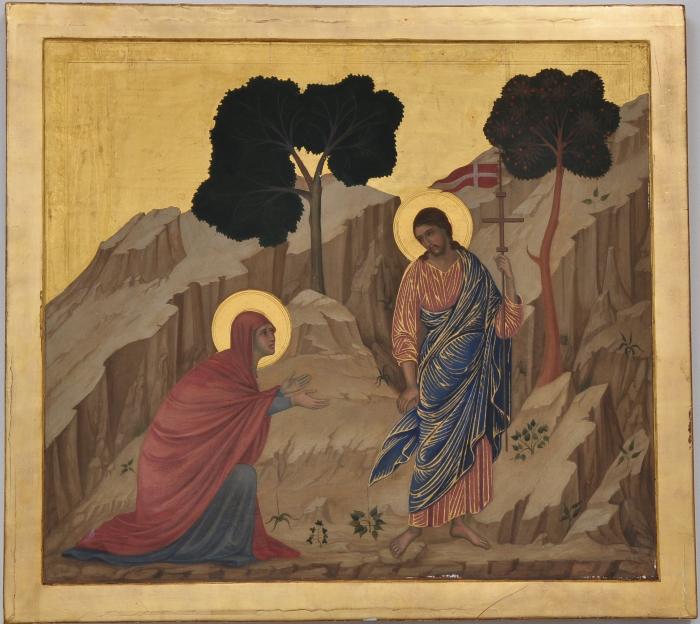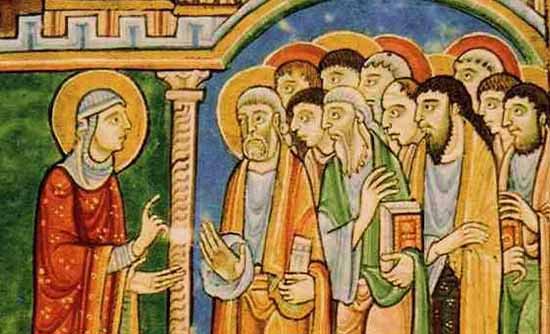Is There Hope for Evangelical Women?
My daughter and I were walking our new puppy when my phone buzzed. It was a twitter notification from my fellow blogger Chris Gehrz. He had tweeted about Beth Moore’s open letter. I stopped dead and started reading.
This was a mistake. We had only had our new puppy a few days and hadn’t yet convinced her to stop teething on us (actually, we still haven’t succeeded in this…). But I was so stunned by Beth Moore’s letter that it really did take a few seconds before I felt those sharp teeth gnawing at my ankle. It was also a few seconds before I realized how far I was lagging behind my daughter.
“Mom!,” she yelled. “What are you doing?”
I looked at her, standing far ahead on the path. She is tall for her 2nd-grade years. She is talkative, happy, and believes she can do anything. She announced just a few weeks ago that she prefers Nancy Drew to Harry Potter because Nancy is a real person who can solve her own problems just by using her brain. She stood there, impatient, with her hands on her hips frowning at my slowness.
That image of my daughter stayed with me throughout the week. So did Beth Moore’s letter. Indeed, I couldn’t seem to think about the letter without picturing my daughter standing on the path in front of me. In my mind they were connected, and I knew exactly why.
Beth Moore’s letter gave me hope for my daughter.
Maybe my daughter will not have to carry the heavy weight of misogynist theology that has weighed so many of us down for so long. Maybe she will not have to encounter the sexist and demeaning attitudes endured by Beth Moore. Maybe my daughter will be free to exercise her spiritual calling, whatever it may be, without artificial limits placed on her by (primarily) male leaders. Maybe my daughter will live in a better world.
Beth Moore’s courage to speak out, even at the cost of her reputation and possibly her ministry, gave me hope that the evangelical world would finally listen. Chris Gehrz noted recently how Beth Moore pleaded in her letter for evangelical men to broaden their narrow views about women’s roles. She asked them to recognize “the skewed attitudes many of your sisters encounter. Many churches quick to teach submission are often slow to point out that women were also among the followers of Christ (Luke 8), that the first recorded word out of His resurrected mouth was ‘woman’ (John 20:15) and that same woman was the first evangelist.” I love Chris Gehrz’s penultimate sentence. “This time may men have ears to hear voices like Beth Moore’s.”
My hope increased further with the breaking news about Paige Patterson. Now, like Beth Moore’s letter, this news told an awful story about Christian men devaluing and mistreating women. Patterson’s comments sexualizing the body of a young girl should have gotten a youth pastor fired from any responsible church. His bragging (regardless of the veracity of the tale) that he encouraged a woman to stay in a physically abusive relationship, even when she showed up to church with two black eyes, is horrific. What is even more horrific is that after he made these public comments, Christians continued to listen to his sermons and support him.
Unfortunately none of the news about Paige Patterson surprised me. My husband went to Southeastern Baptist Theological Seminary when I was working on my doctorate in Medieval History at the University of North Carolina at Chapel Hill. We figured out Paige Patterson pretty quickly. The shocking (at least to me) stories about the pastor’s wife class that he endorsed and was taught by his wife (my husband always joked that I should take it just to see….I never did) and the methods he used to silence dissenting voices both then and now indicate his overall attitudes about hierarchy and power. As Ed Stetzer wrote about his experience with the SBC president, “No one criticizes Paige Patterson and keeps their job.”
Paige Patterson, like the men called out by Beth Moore, had gotten away with stuff like this for years. Finally he was being called out on the national carpet.

And the people leading the charge were women. In a letter read around the evangelical world, Southern Baptist women admonished their male leaders. “The world is watching us all, brothers. They wonder how we could possibly be part of a denomination that counts Dr. Patterson as a leader. They wonder if the Jesus of the Bible is like such men.” I don’t usually sign petitions, but—if I was still an SBC woman—I would have signed this letter.
Is there hope? I really think there is.
I think we are standing at a moment when many evangelical women realize that something is very wrong and are willing to do something about it.
For me, the most disturbing aspect of the Paige Patterson story isn’t what Paige Patterson did. Given his beliefs about women, I am not surprised when he acts badly toward women. What disturbs me the most is how many Christians follow him. As a historian, I am interested in how ideas influence behavior. I am interested in how so many Christians are complicit in allowing their pastor to openly sexualize the body of an underage girl and approve of wife-beating.
Why do Christians continue to follow men like Paige Patterson?
I went to the Southwestern Baptist Theological Seminary website looking for answers. I pulled up a list of courses offered in Fall 2018, as well as a list of textbooks assigned for Spring 2018. This is what I found.
There were 148 listed courses for Fall 2018, excluding the Applied Ministry/internships and Music courses (and, I confess, I did these counts quickly).
Only about 8 of these were history courses—3 on Baptist history, 2 on biblical archaeology/history, and 3 on church history. I looked up the textbooks used for the church history courses in the Spring 2018 list, and found that they were The Story of Christianity by Justo L. Gonzlez and the sourcebook Readings in the History of Christian Theology by William C. Placher. I checked out volumes of both of these from my library (1984 and 1988 editions). Readings in the History of Christian Theology, Volume 1, From Its Beginnings to the Eve of the Reformation contains 71 primary sources. Only one, out of the 1500 years of history, was written by a woman–an excerpt from Revelations of Divine Love by the late medieval English anchoress Julian of Norwich. It is noteworthy that this particular (and very short—2 ½ pages) excerpt emphasizes her as “a simple unlearned creature.” In The Story of Christianity, Volume 1, The Early Church to the Dawn of the Reformation, only one woman (St. Macrina)–in contrast to more than thirty men–is specifically mentioned in the 36 chapter and sub-chapter headings. I estimated there are around 900 total entries (I counted up to 500, and then estimated for the remaining columns) in the index. Only 31 of these entries are for individual women; 23 entries are for virgins (2), the virgin birth (1), women (generally, 17), and widows (3). Thus, there were approximately 54 entries about women within the approximately 900 total entries.
What does this mean? In the primary source reader, 98.6% of the entries included were written by men. In the Story of Christianity textbook, men comprise 94% of the narrative. I can’t help but think of Miss Morland in Jane Austen’s Northanger Abbey who complained that she could not be interested in history because “the men (are) all so good for nothing, and (there are) hardly any women at all–it is very tiresome.”
Only 4 of the 148 listed courses for Fall 2018 at SWBTS explicitly mentioned men and women—Biblical Theology of Manhood, Biblical Theology of Womanhood, Text Driven Commentary for Women, and Women and Discipleship. The three courses which mentioned women were all under separate headings of “Women’s Ministry” and “Women’s Studies”. I also found courses for “Ministry to Women,” “Introduction to Women’s Studies,” “Contemporary Evangelism for Women,” and “Biblical Counseling for Women” in the Spring 2018 textbook list (all listed as Women’s Studies and Women’s Ministry courses). The course for “Biblical Theology of Manhood” was under “Systematic Theology” (along with a course on “Jesus Christ” and “Systematic Theology I, II, and III”). The course for “Biblical Theology of Womanhood” was not under “Systematic Theology”; it was segregated under “Women’s Studies.” The textbooks assigned for “Introduction to Women’s Studies” were Wayne Grudem and John Piper’s Recovering Biblial Manhood and Womanhood and Rebecca Merrill Groothuis and Ronald W. Pierce’s Discovering Biblical Equality: Complementarity Without Hierarchy.
I could continue, but I think you get my point. The website states that the seminary is currently training more than 3000 students in cooperation with 47,000 local Southern Baptist churches. Those students are learning that women played a miniscule role in church history. They are learning that women hardly ever played leadership roles in church history. They are learning that men’s voices matter more than women’s voices. They are learning that classes about women and for women should be segregated under separate headings and taught by women for women. They are learning that theology about “Manhood” is as important as courses about Jesus and Systematic Theology, while theology about “Womanhood” belongs only in Women’s Studies (and I presume taken mostly by women).
From this perspective, should we be surprised that so many SWBTS seminary students and Baptist pastors continue to support Paige Patterson? Should we be surprised that women are excluded from SBC ministry and leadership roles when SBC pastors are never taught about the women in history who did these things? Should we be surprised that complementarianism continues to thrive when more than 3000 students (multiplying every year as students graduate) connected to 47,000 different churches are taught a complementarian framework for male and female roles (see the textbooks by Grudem, Piper, Groothuis, and Pierce)?*
Beth Moore has made me hopeful, but there is still a great deal of work to be done.
If Evangelical Christians are going to change their attitudes toward women, they have to learn the important role that women really have played throughout church history. They have to recognize women as leaders, teachers, preachers, evangelists, and apostles–not just as domestic caregivers and support staff. Gracy Olmstead recently wrote in the Washington Post that, “Marginalizing women ignores rich church history going back to life of Jesus.” She is exactly right.
If we want to change attitudes towards women, we have to better educate Christians about the reality of women’s roles in church history.
Only then will the world be a better place for my daughter.
It is time we changed the historical conversation about Christian women. I propose we start with seminary textbooks.
*as per the Discovering Biblical Equality book: my apologies for seeming to suggest it taught complementarianism. I confess the overwhelming nature of the classes at SWBTS combined with the Grudem/Piper textbook combined with the SBC Baptist Faith and Message combined with the segregation of Biblical Womanhood away from Biblical Manhood (and connecting Manhood with Systematic Theology and Jesus) made me forget about Discovering Biblical Equality when I penned the word “ONLY”. I stand corrected about Discovering Biblical Equality. I think my point still stands, though. Heck, the listing of courses as “Biblical Manhood” and Biblical Womanhood” strongly suggests the courses favor the Council for Biblical Manhood and Womanhood (Grudem/Piper text) perspective. I would be interested in hearing the perspective of someone who has actually taken the courses.
I am going to take a short break from writing about women and the church. When I begin again, I will wrap up my series on Paul and launch my new series on women in church history. Stay tuned!




